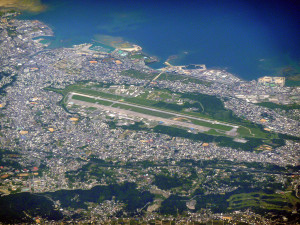Battle for the Base: Gov. Onaga Rescinds Grant for New U.S. Marine Base
The U.S.-Japan Security Alliance experienced a concerning upset this week when Okinawa Governor Takeshi Onaga formally rescinded the land grant for the relocation of the Marine Corps Air Station Futenma. In retaliation, the central government’s Okinawa Defense Bureau swiftly responded by submitting a complaint to nullify Onaga’s efforts and restart construction under the Administrative Appeal Act. This ardent campaign to stop the construction has been characterized by months of bellicose protests at construction sites and resounding support from local residents, especially those in Nago. However, Onaga’s withdrawal of the land grant is just the latest installment in a contentious debate that first began two decades ago.

In 1996, the U.S. and Japanese Governments agreed to the relocation of the Marine Corps Air Station Futenma from Ginowan to a new 400 acre coastal facility in the Henoko district of Nago. This deal generated outrage from the Okinawan population, who believed the deal further augmented the strain on the small-island prefecture. Despite accounting for only 0.6% of Japan’s total territorial area, Okinawa hosts over 60% of U.S. forces deployed in Japan and over one-fifth of the island’s land mass is occupied by the U.S. military. It was this historic tension and simmering acrimony that facilitated Onaga’s rise to power.
Before assuming the role as governor, Onaga served four terms as Mayor of Naha City and was a member of the ruling Liberal Democratic Party headed by Prime Minister Shinzo Abe. During his tenure as mayor, Onaga consistently supported the relocation of Futenma to Henoko. However in 2014, Onaga embarked on a complete political restructuring that resulted in his defection from the LDP and his unwavering resistance to the base relocation proposal. Onaga’s base opposition platform fostered tremendous support, resulting in his election as governor.
In March of this year, Onaga temporarily blocked construction preparations, citing concerns over the fragile marine environment. Despite the momentary stoppage, the central courts issued a stern decision authorizing the construction preparation. Yet the tides turned once again in Onaga’s favor when in July, a third-party committee, in charge of reviewing the legality of the 2013 base land grant approved by Onaga’s predecessor, Hirokazu Nakaima, identified several “legal defects” in Nakaima’s grant based on the Law on Reclamation of Publicly Owned Water Surfaces. The discovery of these “legal defects” helped to engender a monthlong cessation of construction preparations for intensive dialogue purposes. However, these talks ultimately stalled without resolution.
Thus, the tension between the central and prefectural government has now reached a fever pitch as it seems a vicious court battle will soon commence. Despite the prospect of a grueling legal battle, Prime Minister Abe wields the ability to enact a Special Measures Law that would circumvent Onaga’s petitions and allow for the relocation to immediately recommence. In addition, the Abe Administration has clearly conveyed its conviction to see the base’s complete construction, as Defense Minister General Nakatani stated, “The Defense Ministry finds that there was no legal flaw with the reclamation permit and our position remains the same: Governor Onaga’s revocation measure is illegal.”
Aside from exacerbating historic regional schisms, Onaga’s unrelenting position is also drawing immense concern from the U.S. State and Defense Departments. This new marine base lies at the crux of the U.S.-Japan Security Alliance and is paramount to President Obama’s “Pivot to Asia” initiative. Furthermore, the stalling of construction comes at troubling time for the region as China increases its militarization of islands in the South China Sea and continues to assert sovereignty over the Senkaku/Diaoyu Islands. Thus, the uncertainty of the base’s construction could have profound repercussions for Japan’s regional security and ultimately the future of the U.S.-Japan Security Alliance. The fate of the base now lies in the hands of the court.
